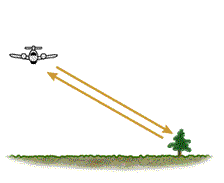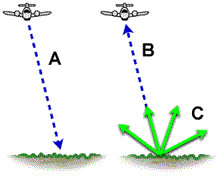Polarimetric scattering
Having defined how to represent a polarized wave, we now describe how an EM wave of a certain polarization is scattered by a target. In this regard, we will use "target" to mean either a discrete reflector or a distributed surface.
The scattering properties of a target can be measured by a polarimetric radar, as depicted in Figure 1-10. The radar system illuminates the target with an incident wave (A), and the wave is scattered in all directions by the target (C). The radar system records the part of the scattered wave that is directed back towards the receiving antenna (B). Often the receiving antenna is in the same location as the antenna that transmitted the wave - this is called the monostatic case, and the received energy is referred to as backscatter. By controlling the polarization of the incident wave and measuring the full polarization properties of the backscattered wave, the radar system can be used to learn more about the target than by using a single polarization.
|
|
|
A polarimetric or quadrature polarization radar transmits with two orthogonal polarizations, often linear horizontal (H) and linear vertical (V), and receives the backscattered wave on the same two polarizations. This results in four received channels, i.e. HH, HV, VV and VH, where both the amplitude and relative phase are measured. The measured signals in these four channels represent all the information needed to measure the polarimetric scattering properties of the target - hence the quadrature polarization radar is also called a fully polarimetric radar. In the case of dual polarized radars, some but not the entire target scattering properties can be obtained from the two channels.
Page details
- Date modified:

